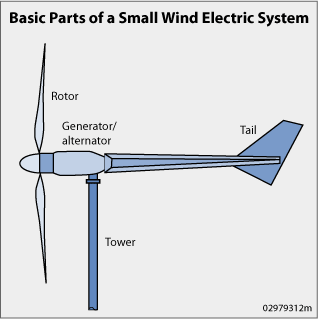DSO Electric Cooperative Inc. | 201 Dakota Drive | Solomon, KS 67480 | PO Box 286 | 1-800-376-3533
How small wind works.
Wind is created by the unequal heating of the Earth's surface by the sun. Wind turbines convert the kinetic energy in wind into clean electricity.
When the wind spins the wind turbine's blades, a rotor captures the kinetic energy of the wind and converts it into rotary motion to drive the generator. The manufacturer can provide information on the maximum wind speed at which the turbine is designed to operate safely. Most turbines have automatic overspeed-governing systems to keep the rotor from spinning out of control in very high winds.
Residential Wind Turbines
Many cooperative members are interested in owning renewable energy systems, particularly wind, for their homes, businesses, or farming operations. A common question asked is how much money can be saved in future electricity costs in comparison to the investment. This comprehensive Small Wind Cash Flow Model (Microsoft Excel) can help you analyze the economics of investing in a small wind turbine. Once you open the spreadsheet, click on the “instructions” tab at the bottom for input and term descriptions. There are many variables that have an impact on the economic viability of a small wind machine. This model allows the user to input many of these variables including:
- project costs
- interest rates
- electricity generated
- retail electric rate
- project life
- grants and loans
- O&M costs
- electricity consumed
- utility's avoided cost of generation
- discount rate


